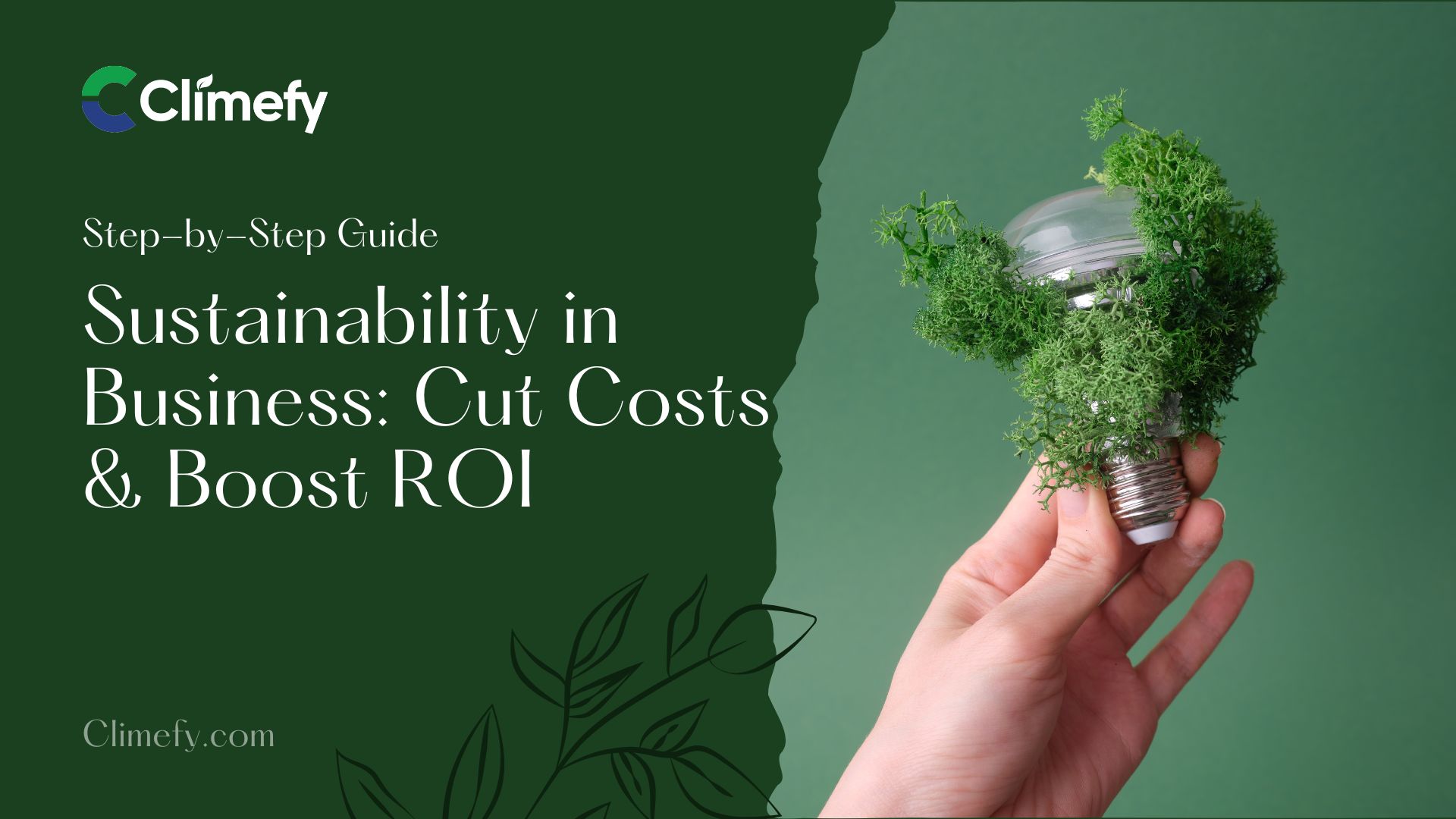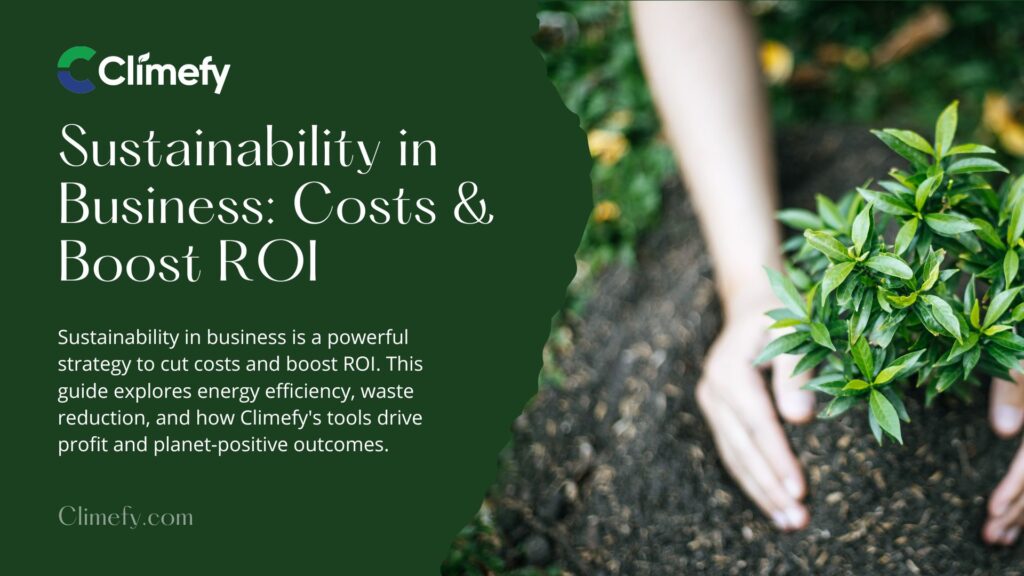
Sustainability in business is no longer a niche concern or a mere public relations tactic; it has emerged as a fundamental driver of financial success, operational efficiency, and long-term resilience. This comprehensive guide will deconstruct the powerful synergy between ecological responsibility and economic performance, demonstrating that going green is one of the most effective strategies to cut costs and boost your Return on Investment (ROI). We will move beyond the jargon to provide an actionable roadmap for integrating sustainability into your core business strategy, transforming it from a cost center into a profit center.
In this definitive guide, you will learn:
Read More:

Sustainable business, often referred to as corporate sustainability, is a holistic management approach that seeks to create long-term value by embracing opportunities and managing risks derived from economic, environmental, and social developments. It is founded on the principle of the “Triple Bottom Line” (TBL or 3Ps): People, Planet, and Profit. A sustainable business operates in a way that is not only economically viable but also beneficial to society and the environment.
The direct impact on profitability is multifaceted. It begins with operational efficiency; by reducing resource consumption, companies directly lower their operational expenses. This includes cutting energy bills, minimizing waste disposal costs, and optimizing water usage. Furthermore, sustainable practices often lead to process innovations that streamline operations, reduce material use, and enhance productivity, all of which contribute directly to a healthier bottom line and a stronger ROI.
The business case for sustainability has solidified to the point where it is now a strategic imperative, not an optional “add-on.” Several converging global trends have made this shift inevitable. Firstly, investor pressure is mounting, with trillions of dollars in assets now being managed according to ESG principles. Secondly, consumer preferences have dramatically shifted, with a majority of global consumers willing to pay more for sustainable products.
Thirdly, a tightening regulatory landscape worldwide, including carbon pricing and mandatory ESG reporting, means that companies must adapt or face financial penalties. Finally, the “war for talent” is being won by companies with a clear purpose; millennials and Gen Z overwhelmingly prefer to work for employers who are committed to positive social and environmental impact.
Energy efficiency and waste reduction are the twin pillars of immediate cost savings in any sustainability program. Energy is a significant and often variable operational expense for most businesses. By implementing energy-efficient technologies and practices, companies can achieve substantial and permanent reductions in their electricity, gas, and fuel bills.
Similarly, waste is a sign of inefficiency; it represents purchased materials that were not converted into sold products or services. By reducing waste, a company not only saves on disposal fees but also on the initial cost of the materials. Embracing a circular economy model, where waste is designed out of the system and materials are reused, can transform a cost center into a source of value.
Reducing a company’s carbon footprint is a systematic process that begins with measurement. The most effective strategies involve a comprehensive approach targeting all three scopes of emissions. The first and most crucial step is to conduct a detailed carbon footprint assessment to establish a baseline. This is where tools like the Climefy carbon calculator for businesses become invaluable, providing a clear picture of your emissions hotspots. Once the baseline is set, the strategy should focus on reduction first, and then offsetting for any remaining, unavoidable emissions.
The connection between robust ESG performance and strong financial performance is increasingly supported by empirical evidence. Companies with high ESG ratings have been shown to exhibit lower volatility, higher profitability, and lower costs of capital. This correlation exists because good ESG practices are indicative of high-quality management, prudent risk oversight, and a long-term strategic orientation. For instance, a company that manages its environmental risks well is less likely to face fines, lawsuits, or reputational damage.
A company with strong social practices (e.g., fair labor policies, diversity, and inclusion) typically enjoys higher employee satisfaction, which leads to increased productivity and lower turnover costs. Good governance ensures transparency and ethical behavior, which builds trust with all stakeholders.
Accurately measuring carbon emissions is the foundational step of any credible climate strategy. The internationally recognized standard for this is the Greenhouse Gas (GHG) Protocol, which categorizes emissions into three scopes. Accurate measurement requires collecting activity data (e.g., kWh of electricity used, liters of fuel consumed, kilometers traveled) and applying the appropriate emission factors to convert that data into CO2 equivalent (CO2e).
While this can be done manually using spreadsheets, it is a complex and error-prone process. This is why specialized carbon accounting software and calculators are essential for accuracy, efficiency, and scalability.
For small and medium-sized businesses looking for a user-friendly starting point, the Climefy carbon calculator for SMEs simplifies this process. For large organizations with complex value chains, Climefy’s calculator for large organizations offers the comprehensive tracking and reporting needed for strategic decarbonization planning.
Embarking on a net-zero journey is a long-term commitment that requires strategic planning and execution. “Net zero” means achieving a balance between the greenhouse gases put into the atmosphere and those taken out. The journey involves setting a science-based target, implementing a deep decarbonization plan across the entire value chain, and neutralizing any remaining emissions with an equivalent amount of carbon removals. This journey is not a one-size-fits-all process, but a structured framework can guide any organization.
Carbon offsetting is a mechanism that allows a company to compensate for its own emissions by financing an equivalent carbon dioxide saving elsewhere. This is done by purchasing carbon credits, where one credit represents the reduction or removal of one metric tonne of CO2e from the atmosphere.
These credits are generated by projects that verifiably reduce emissions, such as renewable energy installations, or remove carbon, such as afforestation and reforestation projects. It is crucial to understand that carbon offsetting is not a substitute for reducing your own emissions. It should be used as a last step in a comprehensive climate strategy, only for neutralizing those emissions that are currently unavoidable after all feasible reduction efforts have been implemented.
Digital tools are revolutionizing sustainability management by transforming it from a manual, siloed, and retrospective activity into an automated, integrated, and real-time strategic function. Digital integration solutions allow businesses to seamlessly collect, analyze, and report on sustainability data.
This eliminates human error, saves countless hours of manual labor, and provides decision-makers with timely insights. For example, APIs can pull energy data directly from utility providers, and IoT sensors can monitor real-time resource consumption on a factory floor. This data can be integrated into enterprise resource planning (ERP) systems, enabling sustainability to be factored into everyday business decisions, from procurement to product design.
A credible and authentic sustainability strategy is deeply integrated into the business model, is backed by tangible actions and investments, and is communicated transparently—including the challenges and setbacks. The biggest pitfall is “greenwashing,” where marketing claims are not supported by real performance. To build authenticity, a company must start with a materiality assessment to identify the ESG issues that matter most to its business and its stakeholders.
Goals must be ambitious, science-based, and tied to executive compensation. Progress must be measured and reported openly, using recognized frameworks. Finally, the strategy must engage employees at all levels, making sustainability a part of the corporate culture, not just a PR initiative.
Absolutely not. While large corporations may have dedicated sustainability teams, the principles of efficiency and waste reduction are often even more impactful for small and medium-sized enterprises (SMEs) because they lead to direct cost savings that improve profitability. Starting with simple, low-cost measures like improving energy efficiency or reducing paper use can yield significant returns. Tools like the Climefy carbon calculator for SMEs are designed to be accessible and affordable for businesses of all sizes.
While often used interchangeably, there is a key distinction. “Carbon neutral” typically means balancing emissions with an equivalent amount of carbon offsets, which can include both reduction and removal projects. “Net zero” is a more rigorous standard. It requires a company to achieve deep decarbonization (typically a 90%+ reduction in line with climate science) across its entire value chain, and then only using permanent carbon removals to neutralize the small remaining amount of emissions. Net zero is the gold standard for corporate climate action.
Frame the discussion in terms of financial risk and opportunity. Speak their language: ROI, risk mitigation, cost reduction, and competitive advantage. Present a business case that highlights the tangible benefits: reduced energy costs, lower waste disposal fees, improved employee productivity, enhanced brand value, and access to green financing. Use case studies from competitors or industry leaders to demonstrate proven success.
Common mistakes include: 1) Treating it as a marketing exercise rather than a strategic business transformation. 2) Failing to get top-level commitment. 3) Not measuring their baseline footprint accurately, which makes it impossible to track progress. 4) Trying to do everything at once instead of focusing on high-impact, material issues. 5) Not engaging employees, leading to a lack of ownership and momentum.
Scope 3 emissions are challenging but critical. Start by engaging your suppliers through questionnaires and collaborative partnerships. You can set expectations by including sustainability criteria in your procurement policies. Encourage your suppliers to measure their own footprints and share the data. Industry collaborations and platforms can also help by providing standardized tools and methodologies for calculating Scope 3 emissions.